Salby M.L. Fundamentals of Atmospheric Physics
Подождите немного. Документ загружается.

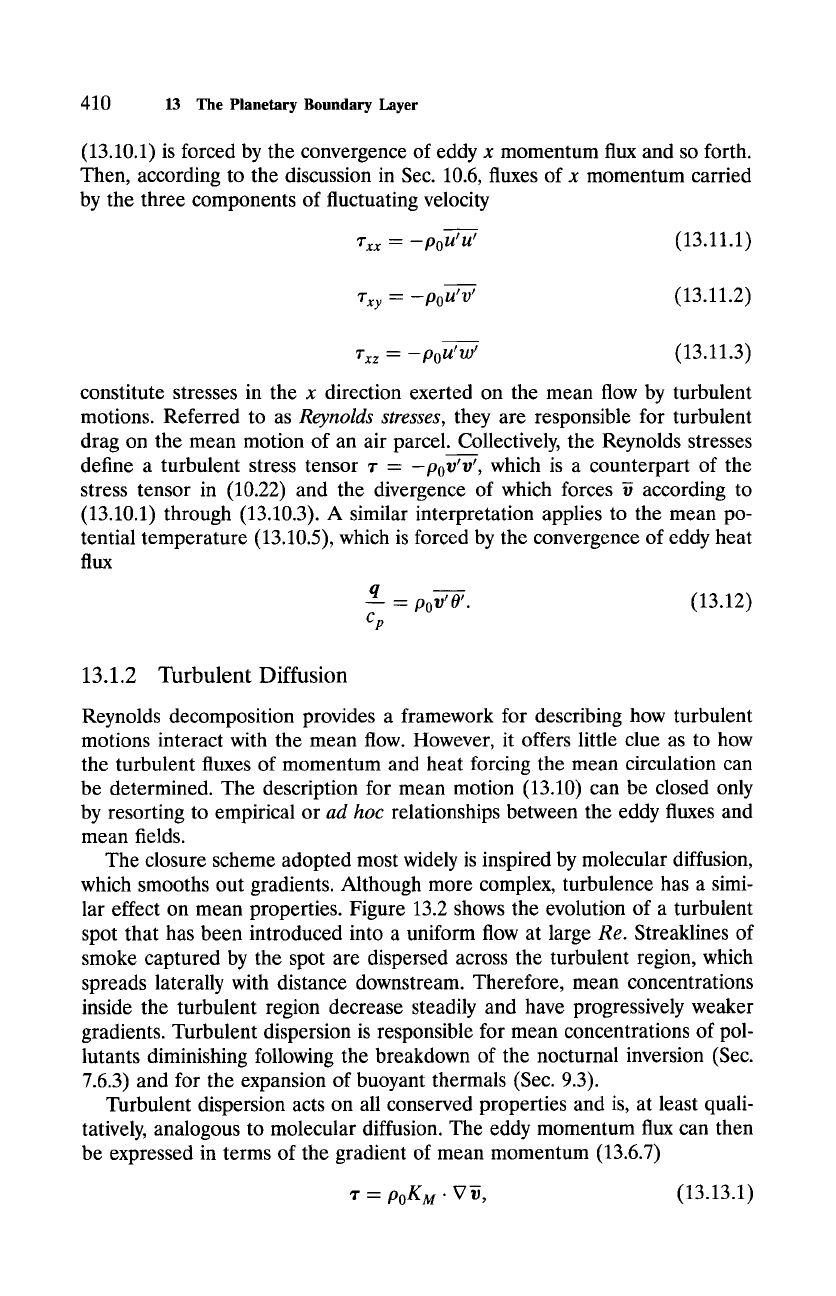
410
13 The Planetary Boundary Layer
(13.10.1) is forced by the convergence of eddy x momentum flux and so forth.
Then, according to the discussion in Sec. 10.6, fluxes of x momentum carried
by the three components of fluctuating velocity
rxx = -poU'U'
(13.11.1)
7"xy "- -- Po Ut l) t
(13.11.2)
rxz - -pou'w '
(13.11.3)
constitute stresses in the x direction exerted on the mean flow by turbulent
motions. Referred to as
Reynolds stresses,
they are responsible for turbulent
drag on the mean motion of an air parcel. Collectively, the Reynolds stresses
define a turbulent stress tensor ~- -
-poV'V',
which is a counterpart of the
stress tensor in (10.22) and the divergence of which forces ~ according to
(13.10.1) through (13.10.3). A similar interpretation applies to the mean po-
tential temperature (13.10.5), which is forced by the convergence of eddy heat
flux
q v' O'
-- = P0 9
(13.12)
Cp
13.1.2 Turbulent Diffusion
Reynolds decomposition provides a framework for describing how turbulent
motions interact with the mean flow. However, it offers little clue as to how
the turbulent fluxes of momentum and heat forcing the mean circulation can
be determined. The description for mean motion (13.10) can be closed only
by resorting to empirical or
ad hoc
relationships between the eddy fluxes and
mean fields.
The closure scheme adopted most widely is inspired by molecular diffusion,
which smooths out gradients. Although more complex, turbulence has a simi-
lar effect on mean properties. Figure 13.2 shows the evolution of a turbulent
spot that has been introduced into a uniform flow at large
Re.
Streaklines of
smoke captured by the spot are dispersed across the turbulent region, which
spreads laterally with distance downstream. Therefore, mean concentrations
inside the turbulent region decrease steadily and have progressively weaker
gradients. Turbulent dispersion is responsible for mean concentrations of pol-
lutants diminishing following the breakdown of the nocturnal inversion (Sec.
7.6.3) and for the expansion of buoyant thermals (Sec. 9.3).
Turbulent dispersion acts on all conserved properties and is, at least quali-
tatively, analogous to molecular diffusion. The eddy momentum flux can then
be expressed in terms of the gradient of mean momentum (13.6.7)
~" = PoKM 9
V ~, (13.13.1)
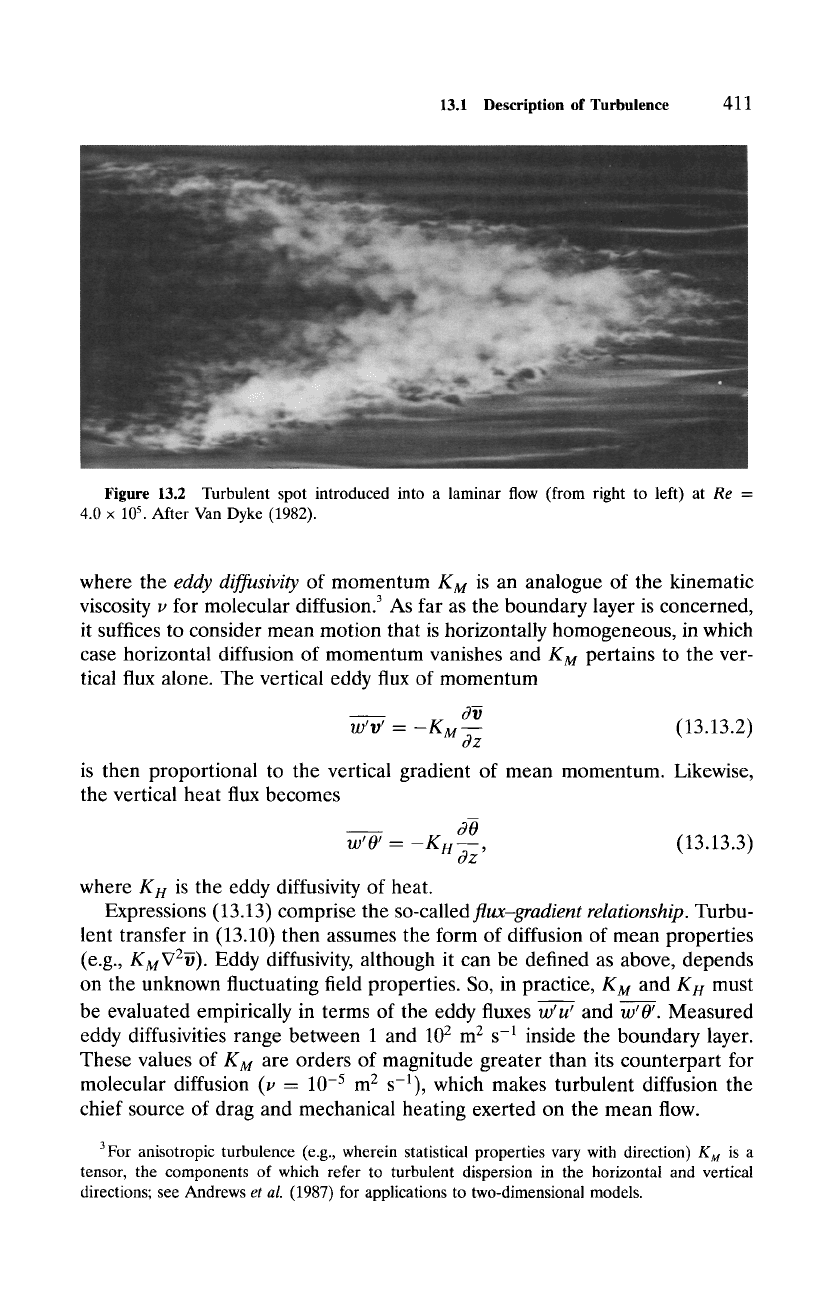
13.1 Description of Turbulence 411
Figure 13.2 Turbulent spot introduced into a laminar flow (from right to left) at
Re =
4.0 x 105. After Van Dyke (1982).
where the
eddy diffusivity
of momentum KM is an analogue of the kinematic
diffusion. As far as the boundary layer is concerned,
viscosity v for molecular " " 3
it suffices to consider mean motion that is horizontally homogeneous, in which
case horizontal diffusion of momentum vanishes and KM pertains to the ver-
tical flux alone. The vertical eddy flux of momentum
w'v' - -KM-~z
(13.13.2)
is then proportional to the vertical gradient of mean momentum. Likewise,
the vertical heat flux becomes
3O
w' O' - -Ki_I-~z ,
(13.13.3)
where K/_/is the eddy diffusivity of heat.
Expressions (13.13) comprise the so-called
flux-gradient relationship.
Turbu-
lent transfer in (13.10) then assumes the form of diffusion of mean properties
(e.g., KMV2~). Eddy diffusivity, although it can be defined as above, depends
on the unknown fluctuating field properties. So, in practice, KM and K/_/must
be evaluated empirically in terms of the eddy fluxes w'u' and w'0'. Measured
eddy diffusivities range between 1 and 10 2 m e s -1 inside the boundary layer.
These values of KM are orders of magnitude greater than its counterpart for
molecular diffusion (v - 10 -5 m e s-l), which makes turbulent diffusion the
chief source of drag and mechanical heating exerted on the mean flow.
3For anisotropic turbulence (e.g., wherein statistical properties vary with direction) KM is a
tensor, the components of which refer to turbulent dispersion in the horizontal and vertical
directions; see Andrews
et al.
(1987) for applications to two-dimensional models.
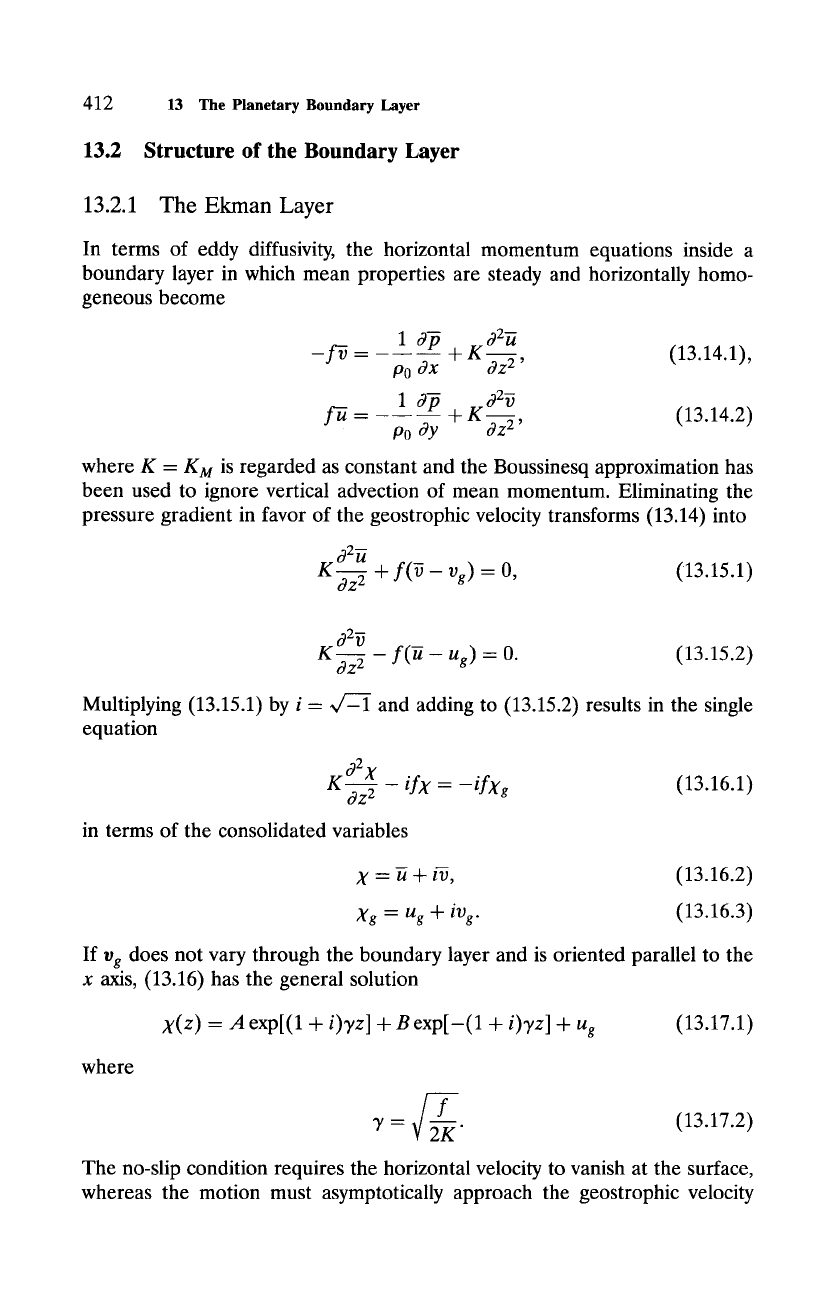
412
13 The Planetary Boundary Layer
13.2
13.2.1
Structure of the Boundary Layer
The Ekman Layer
In terms of eddy diffusivity, the horizontal momentum equations inside a
boundary layer in which mean properties are steady and horizontally homo-
geneous become
1 O-fi
o~2-U
-f-~ = t- K~ (13 14.1)
PO cgX o~Z 2' " '
1 o~p o~2V
f-a = ~- K~ (13.14.2)
Po Oy
~Z 2'
where K = KM is regarded as constant and the Boussinesq approximation has
been used to ignore vertical advection of mean momentum. Eliminating the
pressure gradient in favor of the geostrophic velocity transforms (13.14) into
K02
O9Z2 q-
f(5-
l)g) - 0,
(13.15.1)
Oz e - f(-~- Ug)
= 0. (13.15.2)
Multiplying (13.15.1) by
i = ~/~-1
and adding to (13.15.2) results in the single
equation
d2X
K-~-ffz 2 - if)( = -ifXg
(13.16.1)
in terms of the consolidated variables
X = ~ + if, (13.16.2)
Xg -- Ugn t- iVg.
(13.16.3)
If
llg
does not vary through the boundary layer and is oriented parallel to the
x axis, (13.16) has the general solution
X(z) - A
exp[(1 +
i)yz] + B
exp[-(1 +
i)yz] + Ug
(13.17.1)
where
~f
7= 2-K" (13.17.2)
The no-slip condition requires the horizontal velocity to vanish at the surface,
whereas the motion must asymptotically approach the geostrophic velocity
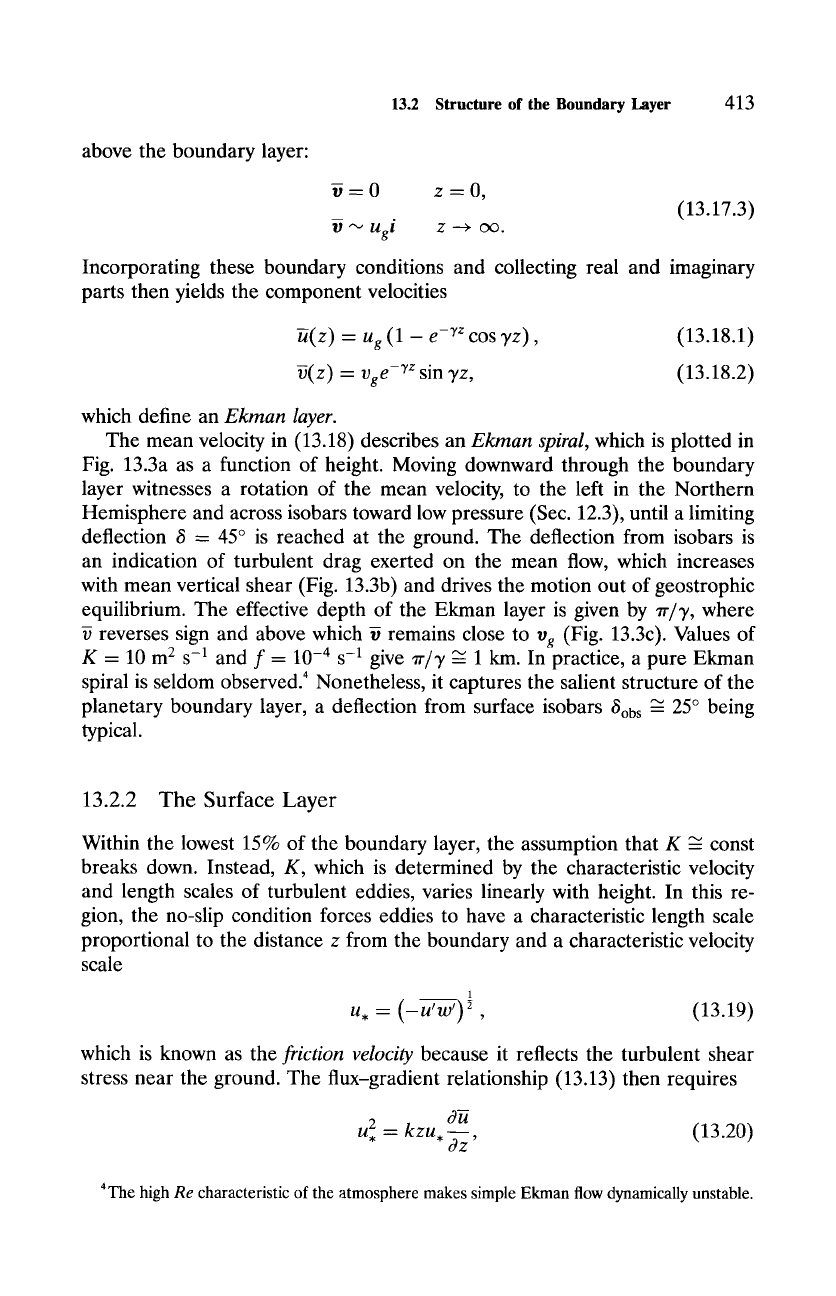
13.2
Structure of the Boundary Layer
413
above the boundary layer:
~=0 z =0,
(13.17.3)
Incorporating these boundary conditions and collecting real and imaginary
parts then yields the component velocities
g(z) - ug (1 - e -v~ cos
yz),
(13.18.1)
V(Z) -- Vge -Tz sin yz, (13.18.2)
which define an
Ekman layer.
The mean velocity in (13.18) describes an
Ekman spiral,
which is plotted in
Fig. 13.3a as a function of height. Moving downward through the boundary
layer witnesses a rotation of the mean velocity, to the left in the Northern
Hemisphere and across isobars toward low pressure (Sec. 12.3), until a limiting
deflection 6 - 45 ~ is reached at the ground. The deflection from isobars is
an indication of turbulent drag exerted on the mean flow, which increases
with mean vertical shear (Fig. 13.3b) and drives the motion out of geostrophic
equilibrium. The effective depth of the Ekman layer is given by
7r/y,
where
reverses sign and above which ~ remains close to
Vg
(Fig. 13.3c). Values of
K - 10 m 2
S -1
and f-
10 .4 s -1
give
7r/y
~ 1 km. In practice, a pure Ekman
spiral is seldom observed. 4 Nonetheless, it captures the salient structure of the
planetary boundary layer, a deflection from surface isobars
6ob s "~
25 ~ being
typical.
13.2.2 The Surface Layer
Within the lowest 15% of the boundary layer, the assumption that K ~ const
breaks down. Instead, K, which is determined by the characteristic velocity
and length scales of turbulent eddies, varies linearly with height. In this re-
gion, the no-slip condition forces eddies to have a characteristic length scale
proportional to the distance z from the boundary and a characteristic velocity
scale
1
u, - (-u--~ ~ , (13.19)
which is known as the
friction velocity
because it reflects the turbulent shear
stress near the ground. The flux-gradient relationship (13.13) then requires
2 kzu, 0-~
u, - --, (13.20)
8z
4The
high Re characteristic of the atmosphere makes simple Ekman flow dynamically unstable.
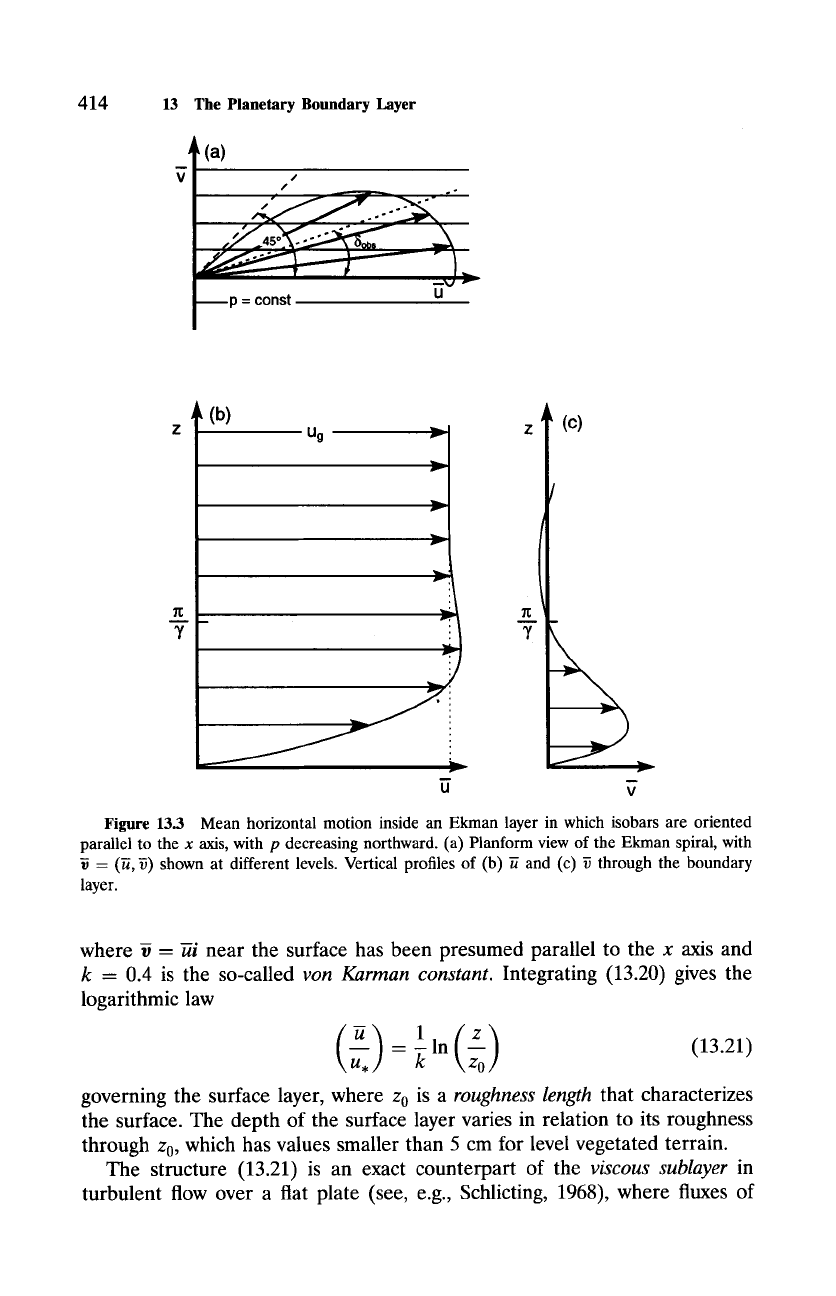
414 13 The Planetary Boundary Layer
~'l (a)
,, ,'
~p = const U
i~(b)
z
uQ ~!I
z (c)
-7- '
i n
u v
Figure 13.3 Mean horizontal motion inside an Ekman layer in which isobars are oriented
parallel to the x axis, with p decreasing northward. (a) Planform view of the Ekman spiral, with
= (~, ~) shown at different levels. Vertical profiles of (b) ~ and (c) ~ through the boundary
layer.
where ~ = ~i near the surface has been presumed parallel to the x axis and
k - 0.4 is the so-called yon Karman constant. Integrating (13.20) gives the
logarithmic law
(~__u,) 1 (z)_~ln ~00 (13.21)
governing the surface layer, where z 0 is a roughness length that characterizes
the surface. The depth of the surface layer varies in relation to its roughness
through z0, which has values smaller than 5 cm for level vegetated terrain.
The structure (13.21) is an exact counterpart of the viscous sublayer in
turbulent flow over a flat plate (see, e.g., Schlicting, 1968), where fluxes of
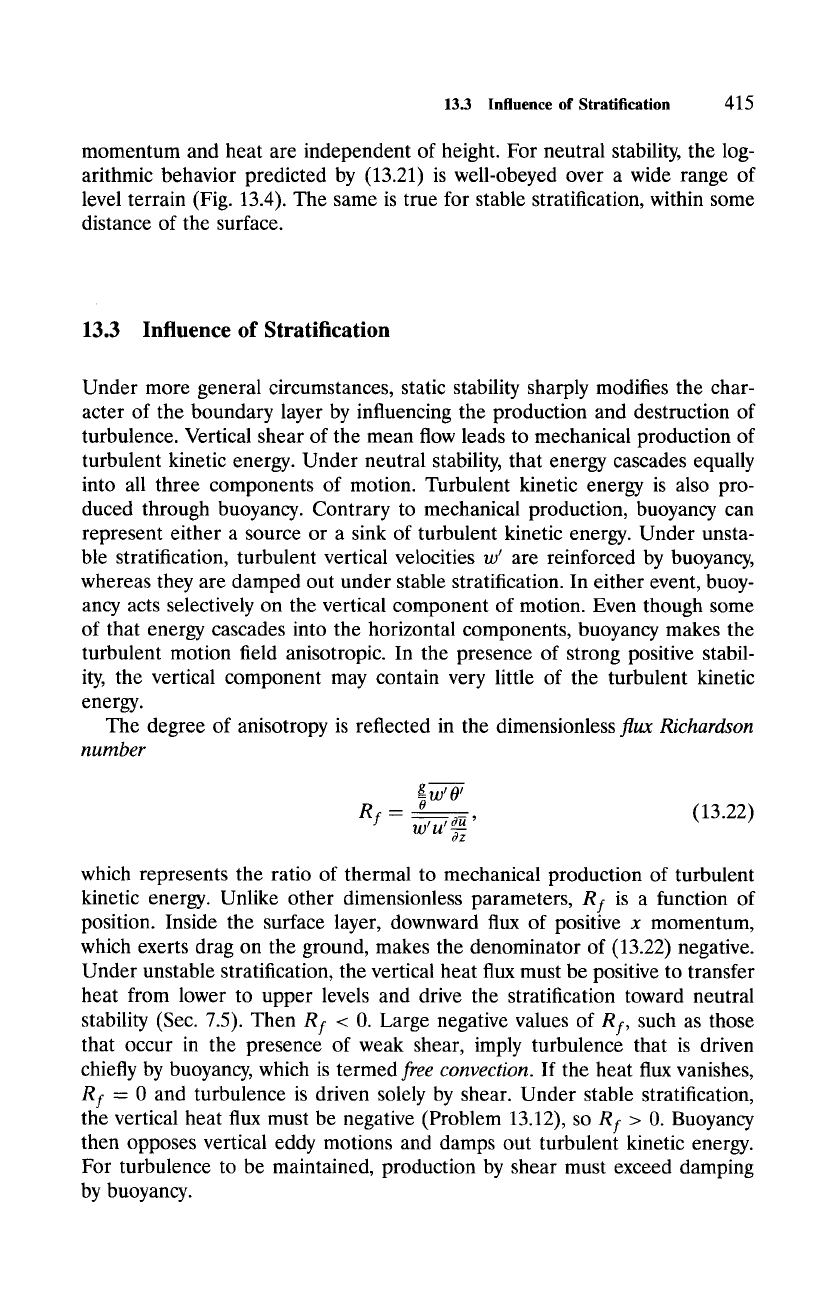
13.3 Influence of Stratification 415
momentum and heat are independent of height. For neutral stability, the log-
arithmic behavior predicted by (13.21) is well-obeyed over a wide range of
level terrain (Fig. 13.4). The same is true for stable stratification, within some
distance of the surface.
13.3 Influence of Stratification
Under more general circumstances, static stability sharply modifies the char-
acter of the boundary layer by influencing the production and destruction of
turbulence. Vertical shear of the mean flow leads to mechanical production of
turbulent kinetic energy. Under neutral stability, that energy cascades equally
into all three components of motion. Turbulent kinetic energy is also pro-
duced through buoyancy. Contrary to mechanical production, buoyancy can
represent either a source or a sink of turbulent kinetic energy. Under unsta-
ble stratification, turbulent vertical velocities w' are reinforced by buoyancy,
whereas they are damped out under stable stratification. In either event, buoy-
ancy acts selectively on the vertical component of motion. Even though some
of that energy cascades into the horizontal components, buoyancy makes the
turbulent motion field anisotropic. In the presence of strong positive stabil-
ity, the vertical component may contain very little of the turbulent kinetic
energy.
The degree of anisotropy is reflected in the dimensionless
flux Richardson
number
g W f 0 /
0
RZ
= ~o~, (13.22)
T~
which represents the ratio of thermal to mechanical production of turbulent
kinetic energy. Unlike other dimensionless parameters, Rf is a function of
position. Inside the surface layer, downward flux of positive x momentum,
which exerts drag on the ground, makes the denominator of (13.22) negative.
Under unstable stratification, the vertical heat flux must be positive to transfer
heat from lower to upper levels and drive the stratification toward neutral
stability (Sec. 7.5). Then
Rf
< 0. Large negative values of Rf, such as those
that occur in the presence of weak shear, imply turbulence that is driven
chiefly by buoyancy, which is termed
free convection.
If the heat flux vanishes,
Rf
= 0 and turbulence is driven solely by shear. Under stable stratification,
the vertical heat flux must be negative (Problem 13.12), so Rf > 0. Buoyancy
then opposes vertical eddy motions and damps out turbulent kinetic energy.
For turbulence to be maintained, production by shear must exceed damping
by buoyancy.
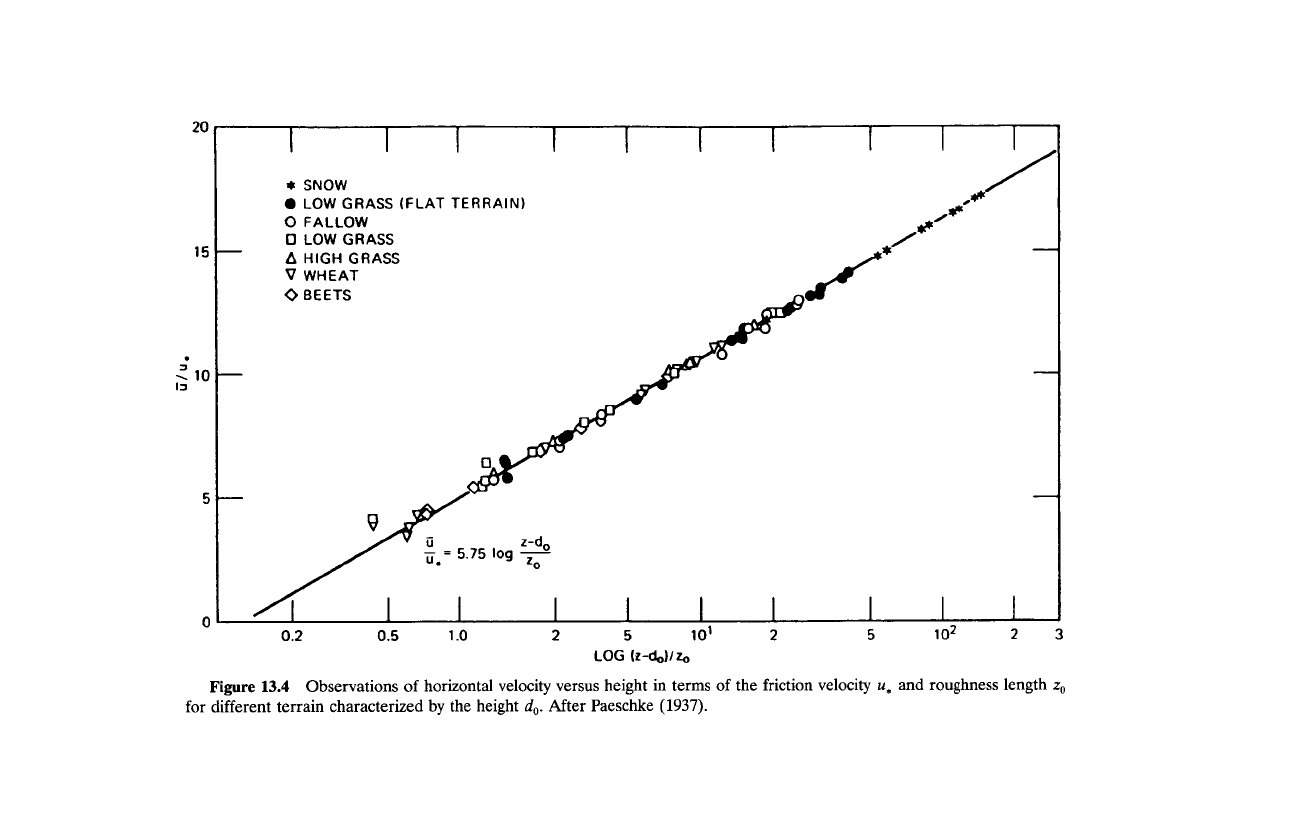
"nl n
15
i
10
13
5
n
*
SNOW
0
LOW GRASS (FLAT TERRAIN)
0
FALLOW
0
LOW GRASS
A
HIGH GRASS
v
WHEAT
0
BEETS
-
-
0.2
0.5
1
.o
2
5
10’
2
5
102
23
LOG
k-&)/~
Figure
13.4
Observations of horizontal velocity versus height in terms of the friction velocity u, and roughness length
z,
for different terrain characterized
by
the height
do.
After Paeschke
(1937).
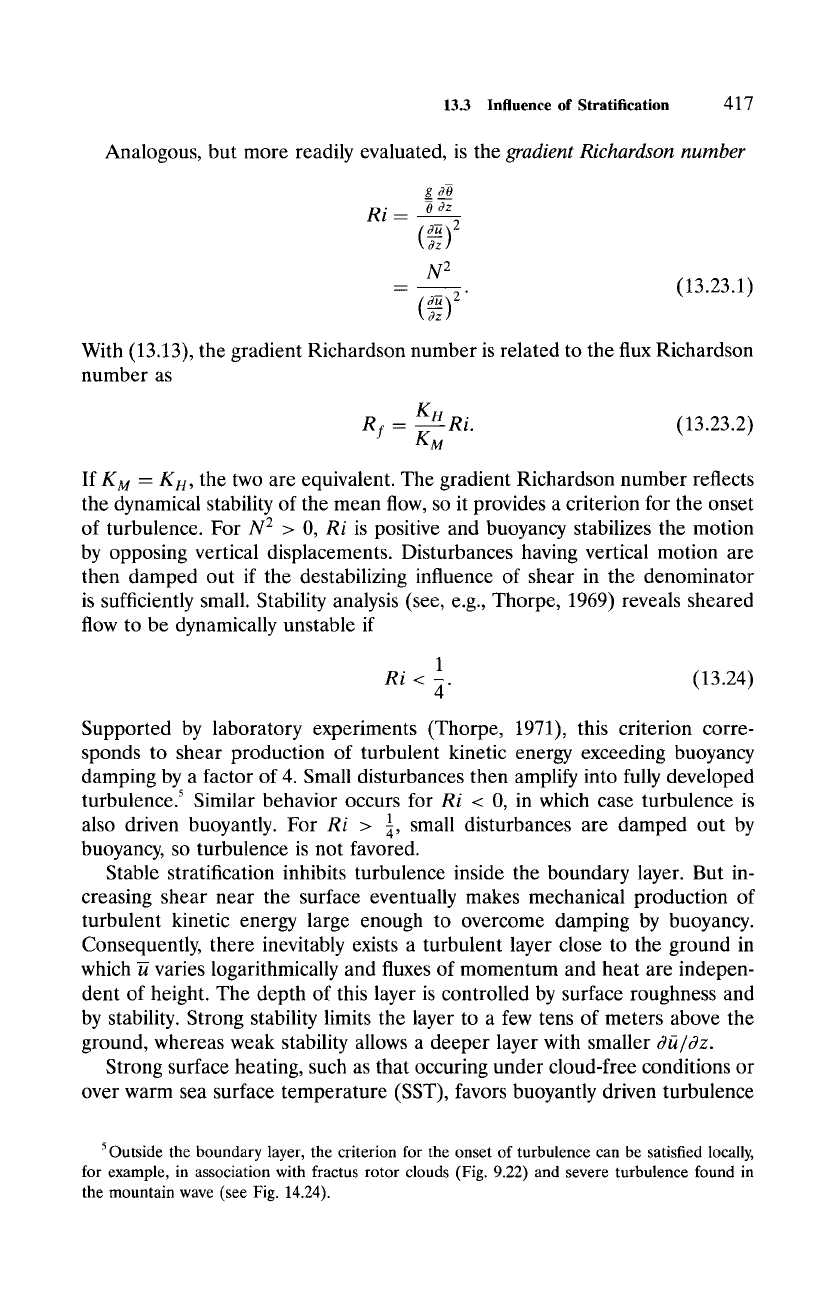
13.3 Influence of Stratification 417
Analogous, but more readily evaluated, is the
gradient Richardson number
g o0
Ri - o oz
3-a] 2
3z]
N 2
= (o~2.
(13.23.1)
3z 1
With (13.13), the gradient Richardson number is related to the flux Richardson
number as
KH
RZ - -~M Ri.
(13.23.2)
If
KM -- KH,
the two are equivalent. The gradient Richardson number reflects
the dynamical stability of the mean flow, so it provides a criterion for the onset
of turbulence. For
N 2 > O, Ri
is positive and buoyancy stabilizes the motion
by opposing vertical displacements. Disturbances having vertical motion are
then damped out if the destabilizing influence of shear in the denominator
is sufficiently small. Stability analysis (see, e.g., Thorpe, 1969) reveals sheared
flow to be dynamically unstable if
1
Ri
< ~. (13.24)
Supported by laboratory experiments (Thorpe, 1971), this criterion corre-
sponds to shear production of turbulent kinetic energy exceeding buoyancy
damping by a factor of 4. Small disturbances then amplify into fully developed
turbulence? Similar behavior occurs for
Ri
< 0, in which case turbulence is
1 small disturbances are damped out by
also driven buoyantly. For
Ri > ~,
buoyancy, so turbulence is not favored.
Stable stratification inhibits turbulence inside the boundary layer. But in-
creasing shear near the surface eventually makes mechanical production of
turbulent kinetic energy large enough to overcome damping by buoyancy.
Consequently, there inevitably exists a turbulent layer close to the ground in
which K varies logarithmically and fluxes of momentum and heat are indepen-
dent of height. The depth of this layer is controlled by surface roughness and
by stability. Strong stability limits the layer to a few tens of meters above the
ground, whereas weak stability allows a deeper layer with smaller
aft/Oz.
Strong surface heating, such as that occuring under cloud-free conditions or
over warm sea surface temperature (SST), favors buoyantly driven turbulence
5 Outside the boundary layer, the criterion for the onset of turbulence can be satisfied locally,
for example, in association with fractus rotor clouds (Fig. 9.22) and severe turbulence found in
the mountain wave (see Fig. 14.24).
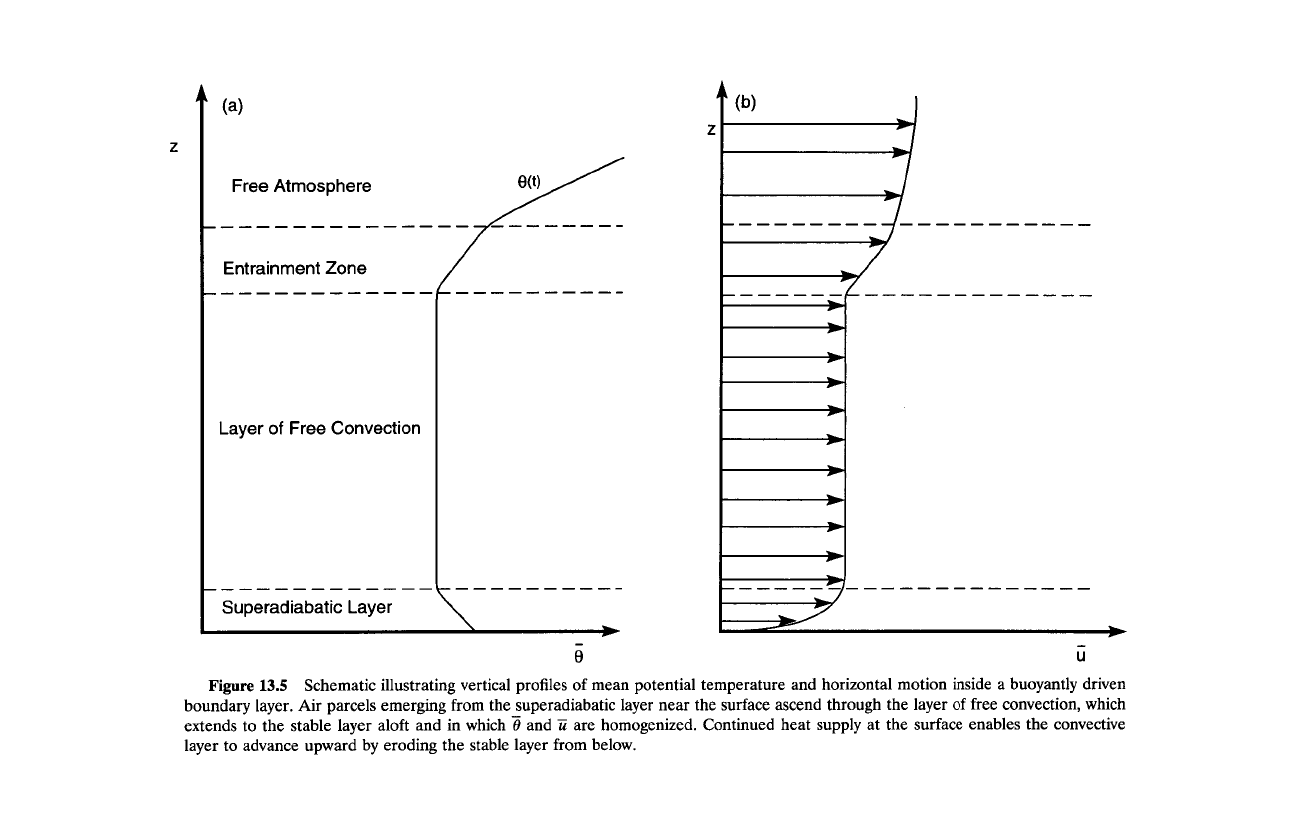
z
Entrainment Zone
------
Layer
of
Free Convection
*
Superadiabatic Layer
-
0
U
Figure
13.5
Schematic illustrating vertical profiles
of
mean potential temperature and horizontal motion inside
a
buoyantly driven
boundary layer. Air parcels emerging from the superadiabatic layer near the surface ascend through the layer
of
free convection, which
extends to the stable layer aloft and in which
3
and
ii
are homogenized. Continued heat supply at the surface enables the convective
layer to advance upward by eroding the stable layer from below.
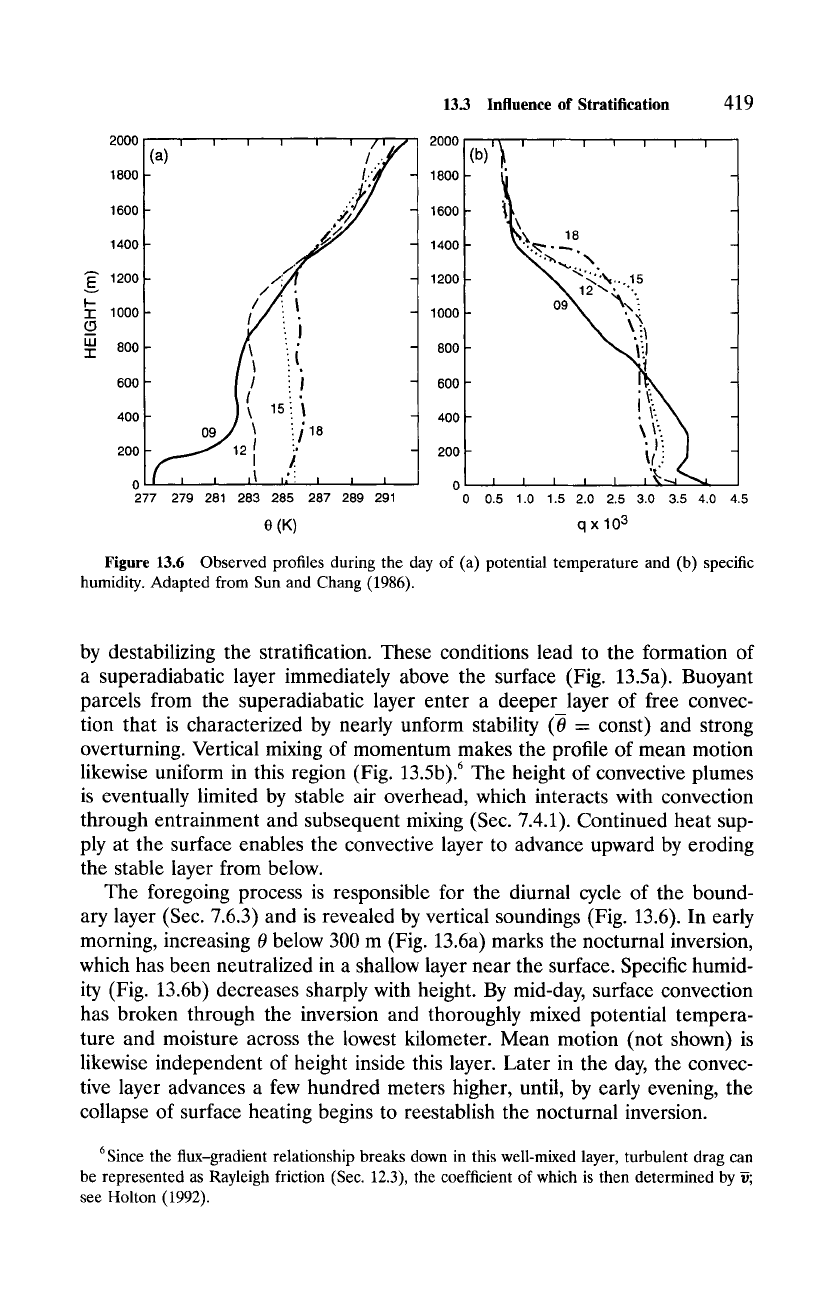
13.3
Influence of Stratification
419
2000
1800
1600
1400
"E" 1200
I'-
"1" 1000
(5
m
u.I 800
"r
600
400
200
I I I I
(a)
=
- 7:'
/i
l,Y
-
i
_ 15.'~
I "
118
-f /
277 279 281 283 285 287 289 291
' ' ' /'t/
h r ..
~
o"
i
i _
i
I
2000
1800
1600
1400
1200
1000
800
600
400
200
(b)'~i ' ' , , , , ,
9
18
- ~
":':'"~"~.. 15
\
12~. "'.
09~-
\:
_
_
'1"
- ~t~
0 t
0 0.5 1.0 1.5 2.0 2.5 3.0 3.5 4.0 4.5
0 (K) q x 10 3
Figure 13.6 Observed profiles during the day of (a) potential temperature and (b) specific
humidity. Adapted from Sun and Chang (1986).
by destabilizing the stratification. These conditions lead to the formation of
a superadiabatic layer immediately above the surface (Fig. 13.5a). Buoyant
parcels from the superadiabatic layer enter a deeper layer of free convec-
tion that is characterized by nearly unform stability (0 = const) and strong
overturning. Vertical mixing of momentum makes the profile of mean motion
likewise uniform in this region (Fig.
13.5b). 6 The
height of convective plumes
is eventually limited by stable air overhead, which interacts with convection
through entrainment and subsequent mixing (Sec. 7.4.1). Continued heat sup-
ply at the surface enables the convective layer to advance upward by eroding
the stable layer from below.
The foregoing process is responsible for the diurnal cycle of the bound-
ary layer (Sec. 7.6.3) and is revealed by vertical soundings (Fig. 13.6). In early
morning, increasing 0 below 300 m (Fig. 13.6a) marks the nocturnal inversion,
which has been neutralized in a shallow layer near the surface. Specific humid-
ity (Fig. 13.6b) decreases sharply with height. By mid-day, surface convection
has broken through the inversion and thoroughly mixed potential tempera-
ture and moisture across the lowest kilometer. Mean motion (not shown) is
likewise independent of height inside this layer. Later in the day, the convec-
tive layer advances a few hundred meters higher, until, by early evening, the
collapse of surface heating begins to reestablish the nocturnal inversion.
6Since the flux-gradient relationship breaks down in this well-mixed layer, turbulent drag can
be represented as Rayleigh friction (Sec. 12.3), the coefficient of which is then determined by ~;
see Holton (1992).
